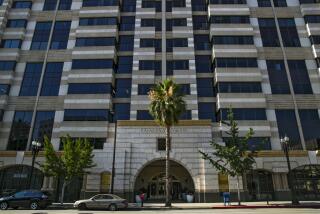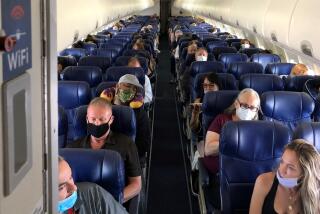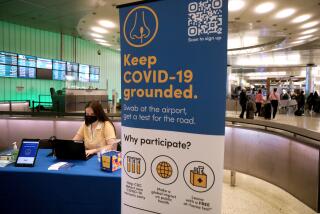His plane-disinfecting invention didn’t take off — until COVID-19 hit
Seven years before the coronavirus pandemic hit, Arthur Kreitenberg, a Los Angeles orthopedic surgeon, came up with an invention in his basement to quickly disinfect an airplane cabin using ultraviolet light.
He even bought airplane seats from the airline graveyard in the Mojave Desert to test his idea.
But the idea did not catch on quickly. His wife joked that Kreitenberg’s tinkering in the basement was “cheaper than having a girlfriend.” At the many aviation trade shows and conferences he attended to pitch his invention, few showed interest.
COVID-19 changed all of that.
Honeywell International, the multinational conglomerate with $37 billion in annual sales, announced this month that it is teaming up with Kreitenberg to build the UV invention and distribute it to the world’s airlines. The company plans to build more than 100 units by the end of July, with production increasing in the following months.
The invention, originally named the GermFalcon, looks like an airline beverage cart equipped with two mechanical arms that stretch out over the plane’s seats like a pair of wings. The arms emit UV light as the cart is pushed down the aisle.
Kreitenberg’s son, Elliot, who gave up his basement batting cage for his dad’s invention, has teamed with his father to get the GermFalcon off the ground.
The contraption can disinfect a cabin in about 10 minutes at a cost of about $10 per plane, according to Honeywell, which is marketing the device as the Honeywell UV Cabin System.
It’s not a novel concept. The U.S. Patent and Trademark Office’s database shows more than 30 patents filed since 1995 that propose using UV light to disinfect water, air, surgical equipment, cellphone screens and catheters, among other things.
Medical experts note that UV light is already used to disinfect hospital operating rooms, and two of Southern California’s swankiest hotels, the Waldorf Astoria Beverly Hills and the Beverly Hilton, recently announced plans to use UV light to disinfect their rooms in response to the coronavirus outbreak.
But experts point out that once an airplane cabin has been disinfected, a passenger infected with COVID-19 can sit down and jeopardize the health of many of the fliers.
The biggest risk of being infected is from close contact with another person, said Peter Chin-Hong, a professor of medicine and an infectious disease specialist at UC San Francisco. Using UV light to disinfect an airplane cabin “could possibly help,” he said. “But UV light is not the end-all and be-all.”
Philip Barruel, the biosafety program manager for laboratory research at UC Davis, agrees, saying UV light may not reach far enough into creases and corners of an airplane cabin to kill the virus.
“There are a lot of unknowns about this virus,” he said.
Kreitenberg acknowledges that his invention will only reduce the chances of getting infected by germs left on the surfaces of an airline cabin and won’t make flying entirely safe.
Still, he points out that UV light can kill several kinds of germs, with the potential to help stem the spread of influenza and other diseases.
Neither Honeywell or Kreitenberg would disclose the financial terms of the partnership or the price they would charge airlines to buy or lease the UV cabin system.
Honeywell began in early June to meet with airlines and demonstrate the UV cabin system but has yet to get a commitment from any carrier.
“The initial reaction from airlines has been very positive,” said Honeywell spokesman Adam Kress. “We believe this product has great potential at airlines worldwide, but we’re starting in-person demonstrations with domestic carriers.”
It all began with a volleyball.
While attending his daughter Zoe’s college volleyball matches during the H1N1 outbreak of 2009, Kreitenberg noticed that the players didn’t shake hands to reduce the chances of spreading the virus. But all the players touched the same volleyball.
Inspired by the use of UV light to disinfect operating rooms, Kreitenberg invented a device — dubbed the Germ Ninja— to quickly disinfect the balls by passing UV light over them. The invention was so successful it was used in the 2012 Summer Olympics in London.
Not long after that, Elliot Kreitenberg flew home from college, trying to sleep with his face resting on the fold-down tray. A fellow flier warned Elliot about the germs on the tray, reminding him that it was flu season. Elliot relayed the story to his father, and the idea for using UV light to disinfect commercial planes was hatched.
A business major from Skidmore College, Elliot wanted to run his own company. After some research and encouragement from a college professor, he decided to go into business with his father to sell the GermFalcon. Elliot became president and co-founder with his father of Dimer LLC, which is named for part of the process that kills viruses with UV light.
The father-son team estimated they visited up to 20 trade shows and conferences, hoping to sell the idea — with no success. One of the challenges was trying to talk directly with an airline executive who had the authority to approve the purchase.
Executives at Virgin America, the California-based carrier launched by Sir Richard Branson, expressed interest in the UV cabin system in 2014, but that sale fell through when Alaska Airlines acquired Virgin America in 2016.
“It seemed as though every conversation we had with airlines or people visiting our booth at trade shows were interested,” Elliot Kreitenberg, 28, said. “Somewhere along the way, it got lost.”
The company stayed afloat over the years thanks to investments, most of which came from doctors.
Once the coronavirus pandemic reached the U.S. early this year, the Kreitenbergs offered to donate the use of the GermFalcon to disinfect planes that were flying passengers in from overseas. A handful of airlines at Los Angeles International Airport accepted the offer, which drew the attention of a few cable television news outlets. It also got the attention of several potential business partners, including Honeywell.
Elliot Kreitenberg said they agreed to partner with Honeywell because it has the “infrastructure and the footprint in the airline industry to overcome barriers of entry” that they had run into.
The father-son team is not done yet. They are now working on a version of the GermFalcon that can be used in classrooms, offices, buses and train stations, among other locations. They call it the UV Hammer.
More to Read
Inside the business of entertainment
The Wide Shot brings you news, analysis and insights on everything from streaming wars to production — and what it all means for the future.
You may occasionally receive promotional content from the Los Angeles Times.











